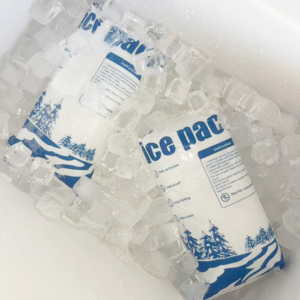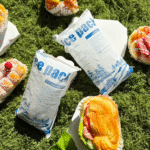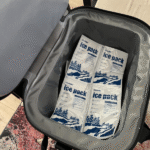Cuando envía bienes sensibles a la temperatura, dry ice bags are essential to maintaining ultra-low temperatures throughout transit. Whether you’re handling biological samples, productos farmaceuticos, o alimentos congelados, understanding how to pack and use dry ice bags correctly is key to ensuring safety, eficiencia, and compliance with evolving regulations. This guide will cover the step-by-step process for using dry ice bags in 2025, focusing on packing, seguridad, and best practices.

What Are Dry Ice Bags and Why Are They Crucial for Shipping?
A bolsa de hielo seco is an insulated, vented pouch specifically designed to hold dry ice in a secure and controlled manner. These bags are essential for maintaining subzero temperatures (below -78.5°C or -109.3°F), ideal for shipping items that need to stay frozen, como muestras biológicas, productos farmaceuticos, y alimentos congelados. A diferencia de las paquetes de hielo tradicionales, dry ice sublimates directly into gas without leaving moisture behind, which prevents water damage to products.
Using dry ice bags ensures that your goods remain at the required low temperatures throughout the shipment. Además, the venting mechanism built into the bags allows the carbon dioxide gas from the sublimating dry ice to escape, preventing pressure buildup and ensuring safety.
Por que importa:
Dry ice bags are critical in cold chain logistics because they provide a controlled environment that preserves product integrity, maintains regulatory compliance, and prevents the loss of product efficacy or spoilage during transit.
How to Pack Dry Ice Safely in a Bag for Shipment?
Guía de embalaje paso a paso
-
Choose the Correct Dry Ice Bag
Seleccione un vented dry ice bag of appropriate size for your shipment. Ensure that there is enough space in the bag for gas expansion as dry ice sublimates. -
Usar equipo de protección
Siempre usa guantes aislados when handling dry ice to avoid frostbite or burns. Handle the dry ice carefully to prevent injury. -
Add the Dry Ice
Place the dry ice inside the bag, ensuring it is securely packed but not overpacked, allowing space for gas to escape through the bag’s vents. -
Sellar la bolsa
Seal the bag but leave a small opening, or use a venting plug to allow dióxido de carbono (Co₂) to escape safely. Never seal dry ice bags completely as this can cause dangerous pressure buildup. -
Etiquetar el paquete
Ensure that the bag is etiquetado correctamente con Y 1845 (Hielo seco), the net weight of the dry ice in kilograms, and any other required hazard markings. This is crucial for regulatory compliance during transit.
What Products Require Dry Ice Bags for Shipping?
Ideal Products for Dry Ice Use
Dry ice bags are typically used for shipping products that require extremely low temperatures throughout the transport process. Estos incluyen:
-
Productos farmacéuticos: Vacunas, temperature-sensitive drugs, y biológicos that must remain frozen.
-
comida congelada: Mariscos, carne, y helado, which need to stay at sub-zero temperatures.
-
Muestras biológicas: Blood samples, cultivos de tejido, y research specimens that require constant freezing.
Why Dry Ice Is Superior for These Products
Dry ice maintains temperatures far below what standard ice can offer, keeping goods frozen without the risk of water damage. Además, since dry ice sublimes into gas, there’s no melting water to cause product contamination or packaging damage.
Safety Regulations for Using Dry Ice Bags in 2025
hielo seco, classified as a dangerous good, must comply with Aquí está Pi 954 y 49 CFR 173.217 regulations for air, mar, and ground transport. These guidelines are designed to minimize hazards related to dióxido de carbono (Co₂) gas. When using dry ice bags, it’s critical to:
-
Mark Properly: Label the shipment with Y 1845 (Hielo seco) and the net weight of dry ice in kilograms.
-
Ventir la bolsa: Ensure the dry ice bag is vented to allow the sublimated CO₂ to escape. Esto evita la acumulación de presión.
-
Follow Carrier Guidelines: Confirm the maximum weight limits of dry ice allowed by your carrier, as some air carriers limit dry ice per package.
Consejo: Always check with your carrier’s specific dry ice transportation guidelines. Some carriers like Fedex y Unión Postal Universal have updated their dry ice transport policies in 2025 to accommodate the latest safety standards.
Choosing the Right Dry Ice Bag for Your Needs
Bag Types and Features
| Tipo de bolsa | Mejor para | Características clave | Lo que significa para ti |
|---|---|---|---|
| Standard Bags | Pequeños envíos, standard shipping | Light insulation, basic venting | Ideal for short routes and small shipments |
| Custom Bags | Large or complex shipments | Heavy-duty insulation, reinforced seams, specialized venting | Better insulation and more durable for long-distance shipments |
| Medical-Grade Bags | Biológicos, productos farmaceuticos | High insulation, regulatory approval | Provides enhanced safety and reliability for sensitive products |
How to Choose the Right One
Select the bag that suits your shipment size, distancia, y temperatura ambiente. Custom bags are ideal for shipments with fragile o valuable items like muestras biológicas that require extra protection. Standard bags work well for smaller shipments where temperature fluctuations are less of a concern.
2025 Tendencias e innovaciones en el envío de hielo seco
Tendencias clave
Como el logística de cadena de frío industry evolves, several innovations are shaping the future of dry ice use:
-
Monitoreo inteligente: Integración de sensores de iot to track temperatura y CO₂ levels durante el transporte. This provides real-time data to ensure compliance and safety.
-
Sustainable Practices: Increasing use of Co₂ reciclado in dry ice production, reducing the carbon footprint.
-
Materiales de aislamiento avanzado: Materiales como paneles de vacío y aerogels are enhancing dry ice efficiency, extending the hold times and reducing sublimation rates.
Impact on You: These trends offer better product preservation, reduced environmental impact, y greater regulatory compliance, making your shipping process more efficient and sustainable.
Common Mistakes to Avoid When Using Dry Ice Bags
| Error | Consequence | Solución |
|---|---|---|
| Sealing the cooler airtight | Acumulación de presión, potential rupture | Leave vent holes or tape the lid loosely |
| Direct contact with dry ice | Packaging film becomes brittle and tears | Use a spacer between the dry ice and packaging |
| Underfilled insulation gaps | Sublimación más rápida, uneven cooling | Fill voids with paper or air pillows |
Para la punta: Ensure that dry ice is placed arriba the product, A medida que el aire frío se hunde, ensuring even cooling of the goods.
Conclusión y recomendaciones
Proper use of bolsas de hielo secas is essential for seguro, eficiente, y obediente shipping of temperature-sensitive goods. By following the latest guidelines, packing correctly, and using the appropriate type of bag for your needs, you can ensure your products remain at the desired temperature throughout the shipping process.
Siguientes pasos:
-
Choose the Right Dry Ice Bag: Assess your shipment requirements and select the appropriate bag type (standard, custom, or medical-grade).
-
Monitor Temperature During Transit: Consider using monitoreo inteligente systems to track temperature and ensure compliance.
-
Adhere to Regulations: Always follow IATA y 49 CFR guidelines for labeling, packing, y ventilación.
Tempk de contacto today for personalized advice and the best dry ice solutions for your business.
Acerca de Tempk
En Templ, we specialize in providing high-quality dry ice bags and cold chain solutions to ensure the safe, eficiente, and compliant transport of temperature-sensitive goods. Our products help businesses maintain product integrity while complying with the latest 2025 regulaciones.
Listo para optimizar la logística de su cadena de frío? Contacto Templ for expert advice and customized solutions tailored to your needs.























